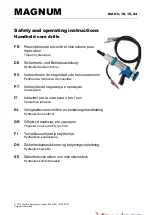
9
Lithium-Ion cordless
hammer drill
WX386 WX386.1
WX386.2 WX386.9
1. CHUCK
2. TORQUE ADJUSTMENT RING
3. TWO-SPEED GEAR CONTROL
4. FORWARD/REVERSE ROTATION CONTROL
5. SOFT GRIP HANDLE
6. BATTERY PACK *
7. BATTERY PACK RELEASE BUTTON*
8. ON/OFF SWITCH
9. SIGHT LIGHT
* Not all the accessories illustrated or
described are included in standard delivery.
TECHNICAL DATA
Type
WX386 WX386.1 WX386.2 WX386.9
(3-designation of machinery, representative of
hammer drill)
WX386
WX386.1 WX386.2 WX386.9
Charger voltage
100-240V ~50/60Hz
Rated voltage
20V Max**
No load speed
0-400/0-1500/min
Impact rate
0-6400/0-24000bpm
Number of clutch
position
18+1+1
Max torque
40N.m
Chuck capacity
13mm
Max.
drilling
capacity
Steel
13mm
Wood
30mm
Brickwork
13mm
Machine weight
1.35kg
1.1kg
** Voltage measured without workload. Initial
battery voltage reaches maximum of 20 volts.
Nominal voltage is 18 volts.
NOISE INFORMATION
A weighted sound pressure
L
pA
: 76,4dB(A)
A weighted sound power
L
wA
: 87,4dB(A)
K
PA
& K
WA
3.0dB(A)
Wear ear protection when sound
pressure is over
80dB(A)
VIBRATION INFORMATION
Vibration total values (triax vector sum) determined
according to EN 60745:
Impact drilling
into concrete
Vibration emission
value a
h,ID
= 4,8m/s²
Uncertainty K = 1,5m/s²
Drilling into metal
Vibration emission
value a
h,D
= 2,5m/s²
Uncertainty K = 1,5m/s²
The declared vibration total value may be used for
comparing one tool with another, and may also be
used in a preliminary assessment of exposure.
WARNING:
The vibration emission value
during actual use of the power tool can differ
from the declared value depending on the ways in
which the tool is used dependant on the following
examples and other variations on how the tool is
used:
How the tool is used and the materials being cut or
drilled.
The tool being in good condition and well maintained
The use the correct accessory for the tool and
ensuring it is sharp and in good condition.
The tightness of the grip on the handles and if any
anti vibration accessories are used.
And the tool is being used as intended by its design
and these instructions.
This tool may cause hand-arm vibration
syndrome if its use is not adequately managed.
WARNING:
To be accurate, an estimation of
exposure level in the actual conditions of use
should take account of all parts of the operating cycle
such as the times when the tool is switched off and
when it is running idle but not actually doing the job.
This may significantly reduce the exposure level over
the total working period.
Helping to minimize your vibration exposure risk.
ALWAYS use sharp chisels, drills and blades.
Maintain this tool in accordance with these
instructions and keep well lubricated (where
appropriate).
If the tool is to be used regularly then invest in anti
vibration accessories.
Plan your work schedule to spread any high vibration
tool use across a number of days.






























